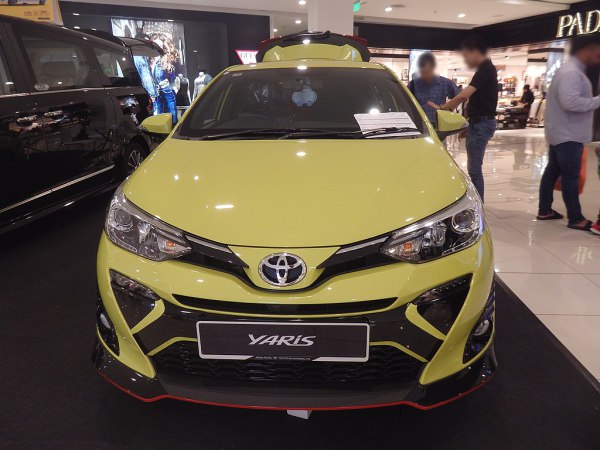




| What is the body type, Toyota Yaris (XP150, facelift 2017)? | Hatchback, 5 Doors, 5 Seats |
|---|---|
| What is the fuel economy, Toyota Yaris (XP150, facelift 2017) 1.5 (107 Hp) CVT? | 5.8 l/100 km 40.55 US mpg 48.7 UK mpg 17.24 km/l |
| How ECO is the car, Toyota Yaris 1.5 (107 Hp) CVT? | 134 g/km CO2 Euro 4 |
| How fast is the car, 2018 Yaris (XP150, facelift 2017) 1.5 (107 Hp) CVT? | 170 km/h | 105.63 mph |
| How much power, Toyota Yaris Hatchback 2018 1.5 (107 Hp) CVT? | 107 Hp, 140 Nm 103.26 lb.-ft. |
| What is the engine size, Toyota Yaris Hatchback 2018 1.5 (107 Hp) CVT? | 1.5 l 1496 cm3 91.29 cu. in. |
| How many cylinders, 2018 Toyota 1.5 (107 Hp) CVT? | 4, Inline |
| What is the drivetrain, Toyota Yaris (XP150, facelift 2017) Hatchback 2018 1.5 (107 Hp) CVT? | Front wheel drive. Internal Combustion engine. The Internal combustion engine (ICE) drives the front wheels of the vehicle. |
| How long is this vehicle, 2018 Toyota Yaris Hatchback? | 4145 mm 163.19 in. |
| How wide is the vehicle, 2018 Toyota Yaris Hatchback? | 1730 mm 68.11 in. |
| What is the curb weight, 2018 Toyota Yaris (XP150, facelift 2017) 1.5 (107 Hp) CVT? | 1090-1120 kg 2403.04 - 2469.18 lbs. |
| How much trunk (boot) space, 2018 Toyota Yaris Hatchback? | 310 l 10.95 cu. ft. |
| How many gears, What type is the gearbox, 2018 Toyota Yaris (XP150, facelift 2017) 1.5 (107 Hp) CVT? | automatic transmission CVT |
| General information | |
|---|---|
| Brand | Toyota |
| Model | Yaris |
| Generation | Yaris (XP150, facelift 2017) |
| Modification (Engine) | 1.5 (107 Hp) CVT |
| Start of production | 2018 year |
| End of production | 2020 year |
| Powertrain Architecture | Internal Combustion engine |
| Body type | Hatchback |
| Seats | 5 |
| Doors | 5 |
| Performance specs | |
| Fuel consumption (economy) - combined | 5.8 l/100 km
40.55 US mpg 48.7 UK mpg 17.24 km/l |
| CO2 emissions | 134 g/km |
| Fuel Type | Petrol (Gasoline) |
| Maximum speed | 170 km/h 105.63 mph |
| Emission standard | Euro 4 |
| Weight-to-power ratio | 10.2 kg/Hp, 98.2 Hp/tonne |
| Weight-to-torque ratio | 7.8 kg/Nm, 128.4 Nm/tonne |
| Engine specs | |
| Power | 107 Hp @ 6000 rpm. |
| Power per litre | 71.5 Hp/l |
| Torque | 140 Nm @ 4200 rpm. 103.26 lb.-ft. @ 4200 rpm. |
| Maximum engine speed | 6200 rpm. |
| Engine layout | Front, Transverse |
| Engine Model/Code | 2NR-FE |
| Engine displacement | 1496 cm3 91.29 cu. in. |
| Number of cylinders | 4 |
| Engine configuration | Inline |
| Cylinder Bore | 72.5 mm 2.85 in. |
| Piston Stroke | 90.6 mm 3.57 in. |
| Compression ratio | 11.5:1 |
| Number of valves per cylinder | 4 |
| Fuel injection system | Multi-port manifold injection |
| Engine aspiration | Naturally aspirated engine |
| Valvetrain | DOHC, Dual VVT-i |
| Engine oil capacity | 3.4 l 3.59 US qt | 2.99 UK qt |
| Engine oil specification |  Log in to see. Log in to see. |
| Coolant | 5.4 l 5.71 US qt | 4.75 UK qt |
| Engine systems | Particulate filter |
| Space, Volume and weights | |
| Kerb Weight | 1090-1120 kg 2403.04 - 2469.18 lbs. |
| Trunk (boot) space - minimum | 310 l 10.95 cu. ft. |
| Fuel tank capacity | 42 l 11.1 US gal | 9.24 UK gal |
| Dimensions | |
| Length | 4145 mm 163.19 in. |
| Width | 1730 mm 68.11 in. |
| Height | 1475 mm 58.07 in. |
| Wheelbase | 2550 mm 100.39 in. |
| Front track | 1455 mm 57.28 in. |
| Rear (Back) track | 1445 mm 56.89 in. |
| Minimum turning circle (turning diameter) | 11.4 m 37.4 ft. |
| Drivetrain, brakes and suspension specs | |
| Drivetrain Architecture | The Internal combustion engine (ICE) drives the front wheels of the vehicle. |
| Drive wheel | Front wheel drive |
| Number of gears and type of gearbox | automatic transmission CVT |
| Front suspension | Independent type McPherson |
| Rear suspension | Torsion |
| Assisting systems | ABS (Anti-lock braking system) |
| Tires size | 195/50 R16 |
| Wheel rims size | 16 |